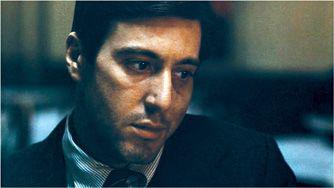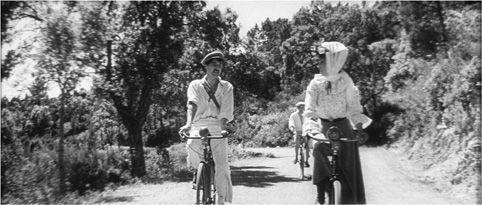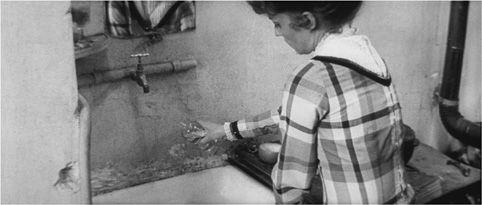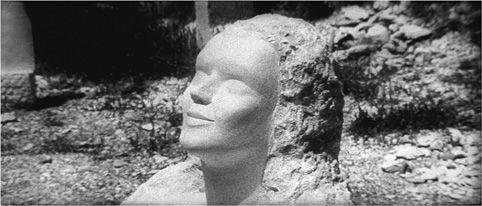B0041VYHGW EBOK (116 page)
Authors: David Bordwell,Kristin Thompson

Alternatively, the acoustic stream may contain much more abrupt contrasts. Contemporary Hollywood films often exploit the dynamic range of Dolby technology to fill chase sequences with startling shifts between low, rumbling engines and whining sirens or squealing tires. In
The Godfather,
just as Michael Corleone is steeling himself to shoot the rival gangster Sollozzo, we hear a loud, metallic screech, presumably from a nearby elevated train. The sound suggests impending danger, both for the victim and for Michael himself: after the murder, his life will change irrevocably
(
7.15
).

7.15 As Michael sits opposite Sollozzo, the sudden rumble and whine of an offscreen train sound all the more harsh when compared with the calm expression on Michael’s face.
Yet another alternative is explored in Alexander Sokurov’s
Alexandra.
A soldier’s grandmother visits him at his camp and wanders freely among the men preparing for war. The sound track includes naturalistic dialogue and effects. But these conventional elements are wrapped in a flow of soft voices, orchestral chords, and snatches of rising and falling soprano singing. The murmuring auditory collage suggests a collective dimension to the old lady’s stay, as if she is visiting on behalf of the unseen families of all the men, perhaps all soldiers’ families throughout history.
Seven Samurai
The ways in which sounds may combine to create an ongoing stream of information is well illustrated by the final battle sequence of Akira Kurosawa’s
Seven Samurai.
In a heavy rain, marauding bandits charge into a village defended by the villagers and the samurai. The torrent and wind form a constant background noise throughout the scene. Before the battle, the conversation of the waiting men, the tread of footsteps, and the sound of swords being drawn are punctuated by long pauses in which we hear only the drumming rain. Suddenly distant horses’ hooves are heard offscreen. This draws our attention from the defenders to the attackers. Then Kurosawa cuts to a long shot of the bandits; their horses’ hooves become abruptly louder. (The scene employs vivid
sound perspective
:
The closer the camera is to a source, the louder the sound.) When the bandits burst into the village, yet another sound element appears—the bandits’ harsh battle cries, which increase steadily in volume as they approach.
The battle begins. The muddy, storm-swept mise-en-scene and rhythmic cutting gain impact from the way in which the incessant rain and splashing are explosively interrupted by brief noises—the screams of the wounded, the splintering of a fence a bandit crashes through, the whinnies of horses, the twang of a samurai’s bowstring, the gurgle of a speared bandit, the screams of women when the bandit chieftain breaks into their hiding place. The sudden intrusion of certain sounds marks abrupt developments in the battle. Such frequent surprises heighten our tension, since the narration frequently shifts us from one line of action to another.
The scene climaxes after the main battle has ended. Offscreen the pounding of horses’ hooves is cut short by a new sound—the sharp crack of a bandit’s rifle shot, which fells one samurai. A long pause, in which we hear only the driving rain, emphasizes the moment. The samurai furiously flings his sword in the direction of the shot and falls dead into the mud. Another samurai splashes toward the bandit chieftain, who has the rifle; another shot cracks out and he falls back, wounded; another pause, in which only the relentless rain is heard. The wounded samurai kills the chieftain. The other samurai gather. At the scene’s end, the sobs of a young samurai, the distant whinnies and hoofbeats of riderless horses, and the rain all fade slowly out.
The relatively dense mix of this sound track gradually introduces sounds that turn our attention to new narrative elements (hooves, battle cries) and then modulates these sounds into a harmonious stream. This stream is then punctuated by abrupt sounds of unusual volume or pitch associated with crucial narrative actions (the archery, women’s screams, the gunshots). Overall, the combination of sounds enhances the unrestricted, objective narration of this sequence, which shows us what happens in various parts of the village rather than confining us to the experience of a single participant.
The choice and combination of sonic materials can also create patterns that run through the film as a whole. We can study this most readily by examining how the filmmaker uses a musical score. Sometimes the filmmaker will select preexisting pieces of music to accompany the images, as Bruce Conner does in using portions of Respighi’s
Pines of Rome
as the sound track for
A Movie.
(See
pp. 376
–377.) In other cases, the music will be composed for the film, and here the filmmaker and the composer make several choices.
The rhythm, melody, harmony, and instrumentation of the music can strongly affect the viewer’s emotional reactions. In addition, a melody or musical phrase can be associated with a particular character, setting, situation, or idea.
Local Hero,
a film about a confused young executive who leaves Texas to close a business deal in a remote Scottish village, uses two major musical themes. A rockabilly tune is heard in the urban Southwest, while a slower, more poignantly folkish melody is associated with the seaside village. In the final scenes, after the young man has returned to Houston, he recalls Scotland with affection, and the film plays the two themes simultaneously.
In contrast, a single musical theme can change its quality when associated with different situations. In
Raising Arizona,
the hapless hero has a terrifying dream in which he envisions a homicidal biker pursuing him, and the accompanying music is appropriately ominous. But at the film’s end, the hero dreams of raising dozens of children, and now the same melody, reorchestrated and played at a calm tempo, conveys a sense of peace and comfort.
“It’s a lot like writing an opera. There’s a lot of form and structure. We’re very conscious that LOTR is one story that has been broken into three parts. My score is a complex piece that has to be structured carefully, musically and thematically, so that all the parts relate to one another.”
— Howard Shore, composer,
The Lord of the Rings
By reordering and varying musical motifs, the filmmaker can subtly compare scenes, trace patterns of development, and suggest implicit meanings. A convenient example is Georges Delerue’s score for François Truffaut’s
Jules and Jim.
Overall, the film’s music reflects the Paris of 1912–1933, the years during which the action takes place; many of the melodies resemble works by Claude Debussy and Erik Satie, two of the most prominent French composers of that era. Virtually the entire score consists of melodies in ¾ meter, many of them in waltz time, and all the main themes are in keys related to A major. These rhythmic and harmonic decisions help unify the film.
More specifically, musical themes are associated with particular aspects of the narrative. For instance, Catherine’s constant search for happiness and freedom outside conventional boundaries is conveyed by her singing the “Tourbillon” (“Whirlwind”) song, which says that life is a constant changing of romantic partners. Settings are also evoked in musical terms. One tune is heard every time the characters are in a café. As the years go by, the tune changes from a mechanical player-piano rendition to a jazzier version played by a black pianist.
The characters’ relations become more strained and complicated over time, and the score reflects this in its development of major motifs. A lyrical melody is first heard when Jules, Jim, and Catherine visit the countryside and bicycle to the beach
(
7.16
).
This “idyll” tune will recur at many points when the characters reunite, but as the years pass, it will become slower in tempo and more somber in instrumentation, and will shift from a major to a minor mode. Another motif that reappears in different guises is a “dangerous love” theme associated with Jim and Catherine. This grave, shimmering waltz is first heard when he visits her apartment and watches her pour a bottle of vitriol down the sink
(
7.17
).
(The acid, she says, is “for lying eyes.”) Thereafter, this harmonically unstable theme, which resembles one of Satie’s
Gymnopédies
for piano, is used to underscore Jim and Catherine’s vertiginous love affair. At times it accompanies scenes of passion, but at other times it accompanies their growing disillusionment and despair.

7.16 In
Jules and Jim,
an idyllic bicycle ride in the country introduces the main musical theme associated with the three characters’ relations.

7.17 Catherine discards the vitriol, which she has said is “for lying eyes.”
The most varied theme is a mysterious phrase first heard on the flute when Jules and Jim encounter a striking ancient statue
(
7.18
).
Later they meet Catherine and discover that she has the statue’s face; a repetition of the musical motif confirms the comparison. Throughout the film, this brief motif is associated with the enigmatic side of Catherine. In the film’s later scenes, this motif is developed in an intriguing way. The bass line (played on harpsichord or strings) that softly accompanied the woodwind tune now comes to the fore, creating a relentless, often harsh, pulsation. This “menace” waltz underscores Catherine’s fling with Albert and accompanies her final vengeance on Jim: driving her car, with him as passenger, into the river.

7.18 The camera slowly arcs around the statue as a new musical motif is introduced.
“So, given this mood-altering potential of music, it becomes a great source of fun, as well as a chance to make a scene that works OK work a whole lot better—to bring out the point of a scene that you haven’t captured in the shooting of it, to excite the audience, to create the impression that something is happening when something isn’t, and also to create little emotional touchstones which you can draw upon as the story changes—so that the music that seemed so innocent and sweet earlier, in new circumstances brings on a whole other set of feelings.”
— Jonathan Demme, director
